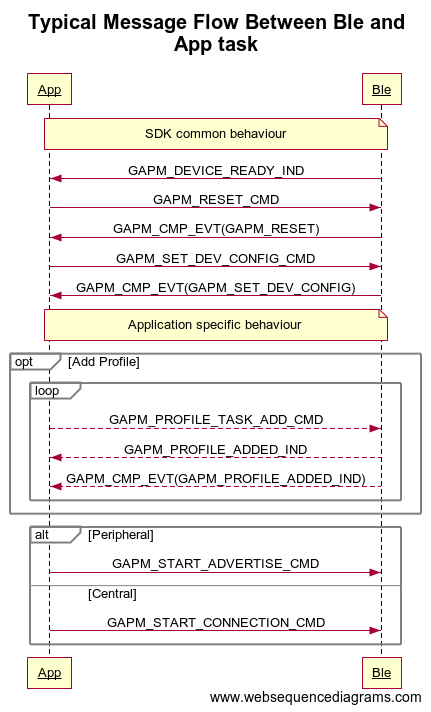Software Architecture with FreeRTOS¶
After the loading process of user image, the system runs to main(). In main(), necessary modules are initialized to work appropriately, then FreeRTOS starts.
There are four FreeRTOS tasks in this system by default.
| Task | Description | Created by | Priority | Scheduled when |
|---|---|---|---|---|
| Idle | System Idle | RTOS kernel | Lowest | No other tasks are in Ready state |
| Timer | Timer Daemon | RTOS kernel | Highest | A RTOS timer expires or the Timer Queue receives a message which is going to manipulate a timer |
| Ble | BLE Stack | SDK code | Highest | BLE Queue receives a message |
| App | User Application | SDK code | Middle | APP Queue receives a message |
There are two queues used for task scheduling between Ble task and App task.
| Queue | Receive messages in | Messages are sent from |
|---|---|---|
| ble_q | Ble Task | App Task/Ble MAC Isr/HWECC Isr |
| app_q | App Task | Ble Task(AHI)/Any Context(ASYNC_CALL) |
After the scheduler of FreeRTOS runs, Ble task initializes BLE software protocol stack and hardware, then it tries to receive messages from ble_q in a infinite loop. Ble task will go into block state if no message in ble_q. When Ble task is blocked, App task with relatively lower priority will run, call user_init() and then receive messages in a infinite loop as well from app_q.
After Ble task succeeds in initialization, a message indicating that BLE protocol stack is ready is generated and sent to app_q. So App task will handle this message once it starts to run. Typically, App task sends GAPM_RESET command to ble_q to continue the application flow. As a response, App task will receive GAPM_CMP_EVT(GAPM_RESET) message.
The following picture shows the typical message flow.
